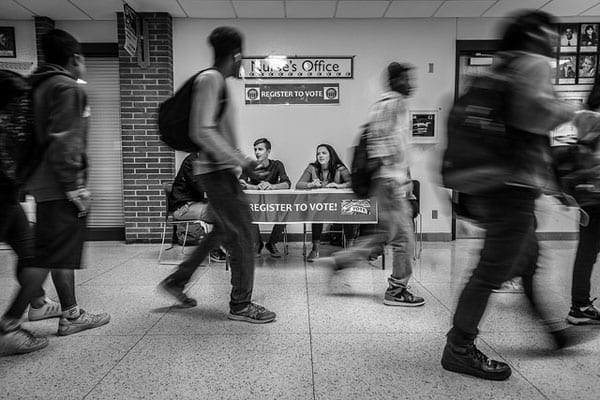
November 6, 2018; National Public Radio, “Education” and Vox
There was great anticipation heading into yesterday’s midterm election of a sea change in young voter participation. Would this largest and most diverse US voting bloc finally make its due mark on an American election? If so, it would be a significant shift from their participation in the last midterm election in 2014. According to the US Census, while overall turnout that year was 42 percent, just 20 percent of eligible voters 18–29 years old voted.
While we still do not have final estimates of youth participation last night, there were many reasons to believe young voter turnout would be different this time. Their activism around immigration, gun violence, and police brutality has helped to change the national discourse dramatically. The challenge for campaigns was how to channel their activism into election participation. In “4 Myths About College Students and Voting,” Zaneeta Daver, director of the All in Campus Democracy Challenge, speaks to that conundrum: “They can’t protest and rally and fight for their causes. They actually need to act. And by acting, I mean participating in elections.”
In Florida, the Parkland activists were making every effort to frame young peoples’ voting in life and death terms. And at least early voting results would suggest they were having an impact. According to Newsweek’s coverage, “Analysis by University of Florida political science professor Daniel Smith found that of the 124,000 people aged 18 to 29 who voted in person at early polling stations as of Thursday, about one-third did not vote in the 2016 election. Around 50 percent of the new voters were also newly registered, the AP reported.”
What issues are motivating this diverse bloc of voters? A recent poll by the W.K. Kellogg Foundation’s Racial Equity Anchor Collaborative of young voters ages 18-24 was intentionally oversampled to hear adequately from young people of color. It found young people of people of color motivated by four issues: racial justice (48 percent); ending police mistreatment of people of color (42 percent); free college (39 percent); and universal health care (39 percent). According to USA Today, the poll makes visible the priorities of young voters often overlooked in the national discourse: “Native Americans in particular are often excluded or underrepresented in national surveys, frequently lumped in with various ethnicities in the “other” category. Yvette Roubideaux, director of the policy research center at the National Congress of American Indians, said the issues of racial and economic injustice are “‘high on the minds’ of Native American communities and youth.”
Sign up for our free newsletters
Subscribe to NPQ's newsletters to have our top stories delivered directly to your inbox.
By signing up, you agree to our privacy policy and terms of use, and to receive messages from NPQ and our partners.
Wealthy Democratic activist Tom Steyer certainly saw the potential for young people to have a significant impact in this election. (NPQ covered this earlier this year.) He invested more than $30 million in an organization called NextGen America, which focused on registering college students in states with competitive races. NextGen America had almost 800 organizers engaged on 421 colleges across the country. Late last night, Vox reported that NextGen America was in fact seeing a marked increase in college-age voter participation, including:
- The University of California-Irvine precinct surpassed 2014 turnout totals with early votes alone, according to NextGen. As of noon Pacific Time, 2018 turnout was more than four times the turnout of 2014, the group reported.
- At Penn State University, NextGen was reporting one in four registered voters had cast ballots by around 6 pm ET. In 2014, fewer than 1 in 20 registered voters at Penn State actually voted.
- At the University of Florida, students cast more than 1,000 additional votes than they did in 2014, by around 6 pm Eastern Time. NextGen estimated a 20 percent turnout jump from 2014.
- In New Hampshire, 2018 vote totals have surpassed 2014 vote totals at most colleges and universities NextGen was tracking by 4 pm.
Steyer’s goals are more long-term than this election’s outcomes, however. In an interview with the Associated Press, he said, “We’re trying really hard to have this be much more of an infrastructure, organizational thing than a two-month campaign. We’re trying to get the broadest possible democracy, the biggest representation.”
CNN exit polls last night confirmed that young people voted overwhelmingly Democratic, with the very youngest voters, those 18-24 years old, at 68 percent.
Age
| Democrat | Republican | No Answer | ||
| 18-24 | 7% | 68% | 31% | 1% |
| 25-29 | 6% | 66% | 32% | 2% |
| 30-39 | 15% | 60% | 36% | 4% |
| 40-49 | 16% | 53% | 46% | 1% |
| 50-64 | 30% | 49% | 49% | 2% |
| 65 and older | 26% | 49% | 50% | 1% |
18316 Respondents
In the coming days, we’ll know with more certainty the extent to which young voters shaped this election’s outcomes, including the Democrats’ winning back of the house of representatives and a number of gubernatorial races. In our analysis of their participation, though, as John Della Volpe of the Harvard Institute of Politics reminds us, “It’s not just today’s college kids that vote at lower rates. Baby boomers and Generation X, the two generations that preceded millennials, voted at low rates when they were young adults, too.”
And this harkens back to Tom Steyer’s comments on building a long-term infrastructure for engagement. In a similar vein, Judith Brown Dianis, executive director of the Advancement Project, commenting on young people’s voting in the midterms, told USA Today: “It won’t just be about voting for us. It’s what are the next steps and what are the next things that are coming. It’s about 2020, it’s about census, but it’s also about what’s happening in between.”













